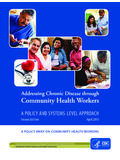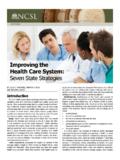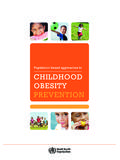Transcription of Developing Culturally Responsive Approaches to Serving ...
1 Developing Culturally Responsive Approaches to Serving Diverse Populations: A Resource Guide for Community-Based OrganizationsMichael L pez, Kerry Hofer, Erin Bumgarner, and Djaniele Taylor March 2017 Publication # 2017-17 ContentsIntroduction ..11. Defining and Understanding Cultural Competency ..32. Choosing Interventions for Diverse Populations ..73. Conducting a Needs Assessment ..154. Measurement Considerations for Diverse Populations ..215. Collaboration Through a Diversity Lens ..246. Workforce Diversity Organizational and Staffing Capabilities ..257. Budgeting The Cost of Responsiveness to Serving Diverse Populations ..26 References ..27 List of TablesTable 1. Resources for defining and understanding cultural competency ..2 Table 2. Resources addressing the understanding of diverse populations ..9 Table 3. Resources for conducting a needs assessment ..17 Table 4. Resources for measurement and measure considerations ..23 Table 5. Resources for collaboration 6.
2 Resources for organizational and staffing capabilities ..25 Table 7. Resources for budgeting ..261 IntroductionThe population is becoming increasingly diverse, particularly with respect to the rapidly growing number of multicultural, multi-lingual low-income children and families. Changes in the diversity of communities across the country have prompted a call to action for many service providers, as well as funders of such programs, to reduce disparities in the access and utilization of services. Given the rapidly changing demographics among high-poverty communities in the United States, it is of the utmost importance that organizations recognize the particular needs of the Culturally and linguistically diverse populations they serve through programmatic services, and that applications for funding announcements appropriately reflect this responsiveness to increasingly diverse populations. Social service programs are finding that in order to keep pace with the demand, community-based organizations (CBOs) must deliver more Culturally Responsive services.
3 Cultural competency is an important way that CBOs can become more Responsive to the needs of the increasingly diverse populations they resource guide, Supporting the Development of Culturally Responsive Approaches to Serving Diverse Populations, is designed to help CBOs serve the needs of their diverse populations. About this guide s multiple audiences and purposesThe first goal of this resource guide is to help community-based service programs more easily find and access available resources on cultural competency in order to better serve their targeted populations. Second, the resource guide aims to help CBOs attract funders who often require evidence of Culturally competent guide is not intended to serve as a training resource for frontline service providers. Rather, it directs users to an existing array of valuable tools and resources that they can consult, use, and adapt to strengthen their capacity to provide more Culturally competent service delivery programs.
4 The resource guide is also intended to help support CBOs in Developing high-quality and successful applications in response to funding announcements. A changing populationAccording to 2013 Census data: 48 percent of children under the age of 18 were members of racial/ethnic groups other than non-Hispanic white. Of this group, Hispanics represented the largest racial/ethnic group (24 percent), followed by non-Hispanic blacks (14 percent) and non-Hispanic Asians (5 percent). Hispanics also are a fast-growing racial/ethnic group, almost tripling as a share of the population between 1980 (9 percent) and 2013 (24 percent). aAcross that Culturally and linguistically diverse population, however, there is great variability within any given racial/ethnic group. Understanding the variability within and across racial/ethnic subgroups is an important step any organization must take to ensure its services are Culturally Responsive to the needs of its targeted POP3 Race and Hispanic Origin Composition: Percentage of Children Ages 0 17 by Race and Hispanic Origin, 1980 2013 and Projected 2014 2050.
5 This guideThis resource guide addresses the following topics: 1. Defining and understanding cultural competency2. Choosing interventions for diverse populations3. Conducting a needs assessment 4. Measurement considerations for diverse populations5. Collaboration through a diversity lens6. Workforce diversity7. BudgetingEach section discusses existing resources that organizations can use to develop or improve their ability to provide Culturally competent programs. Tables within each of the sections provide links to specific resources that correspond to particular needs. 31. Defining and Understanding Cultural CompetencyWhat does cultural competency mean? Whether your organization is looking for resources to improve your practice with diverse populations or you are new to these kinds of services, here is a widely accepted definition of cultural competency: A set of congruent behaviors, attitudes, and policies that come together in a system, agency, or amongst professionals and enables that system, agency, or those professionals to work effectively in cross-cultural A Culturally competent system of care acknowledges and incorporates at all levels the importance of culture, the assessment of cross-cultural relations, vigilance towards the dynamics that result from cultural differences, the expansion of cultural knowledge, and the adaptation of services to meet Culturally unique A critical element of that definition is the phrase at all levels.
6 A model that incorporates this concept is described in Enhancing Cultural Competence in Social Service Agencies: Cultural competence at the broadest level of the organization influences cultural competence at the staff level and ultimately at the level of program design, implementation, and Culturally competent model integrates three dimensions commonly discussed in the research literature: Critical awareness/knowledge an awareness of one s own knowledge and biases of Culturally diverse populations; Skills development effective communication and skills that foster trust with individuals from diverse backgrounds; and Organizational supports organizational systems and policies that facilitate practices that are Responsive to the varied needs of diverse families. How an organization s policies and practices operate depends on the nature of the services it offers. Within the health professions, for example, Culturally competent strategies are likely to focus on attitudes and behaviors related to health services.
7 Thus, the National Institutes of health has included language in its definition of cultural competence (which it refers to cultural respect ) as follows: For the provider of health information or health care, these [cultural] elements influence beliefs and belief systems surrounding health , healing, wellness, illness, disease, and delivery of health services. The concept of cultural respect has a positive effect on patient care delivery by enabling providers to deliver services that are respectful of and Responsive to the health beliefs, practices, and cultural and linguistic needs of diverse Because cultural misunderstandings around health and health care can have life-or-death consequences, cultural competency efforts in that area are robust. Within the Department of health and Human Services (DHHS), the Office of Minority health has established the Center for Linguistic and Cultural Competency in health Care to address the needs of diverse populations.
8 The Office also has developed the National Standards for Culturally and Linguistically Appropriate Services in health and health Care (National CLAS Standards). These standards aim to improve health care quality and advance health equity by establishing a framework for organizations to serve the nation s increasingly diverse communities. 4 Similarly, the National Association of Social Workers5 includes provisions within its Code of Ethics that hold social workers to be Culturally competent. For example, social workers are expected to have a knowledge base of their clients cultures and be able to demonstrate competence in the provision of services that are sensitive to clients cultures and to differences among people and cultural groups. CultureThe integrated pattern of human behavior that includes thoughts, communications, actions, customs, beliefs, values, and institutions of a racial, ethnic, religious, or social group. Cross et respectWhen developed and implemented as a framework, cultural respect enables systems, agencies, and groups of professionals to function effectively to understand the needs of groups accessing health information and health care or participating in research-in an inclusive partnership where the provider and the user of the information meet on common ground.
9 National Institutes of HealthCultural competenceCultural competence refers to the process by which individuals and systems respond respectfully and effectively to people of all cultures, languages, classes, races, ethnic backgrounds, religions, spiritual traditions, immigration status, and other diversity factors in a manner that recognizes, affirms, and values the worth of individuals, families, and communities and protects and preserves the dignity of each. National Association of Social Workers4 Implications for social service providers/practitioners A good way for an organization to start building trust and improving communication among staff and individuals served is to identify which definition of cultural competence fits best. Here are some activities that can be useful: Inviting discussions with members of different cultural groups to gather opinions and viewpoints that are truly representative. Assessing the organization s current strengths and weaknesses in providing Culturally competent services.
10 Revising the mission statement to incorporate cultural competency. Developing goals and identifying milestones to measure progress. Identifying responsible parties who will help ensure that conversations about cultural competency are ongoing and make adequate progress. Dedicating funds and resources to making improvements. Resources and toolsOrganizations may find the resources in Table 1 helpful as they work toward achieving a common understanding of cultural competency, responsiveness, and relevance to their program 1. Resources for defining and understanding cultural competencyResourceDescriptionEnhancing Cultural Competence in Social Service Agencies: A Promising Approach to Serving Diverse Children and Families Calzada & Suarez-Balcazar, 2014 Summarizes the existing research on cultural competence in social services. Describes cultural competence and provides concrete strategies for strengthening cultural competence in social services.

















